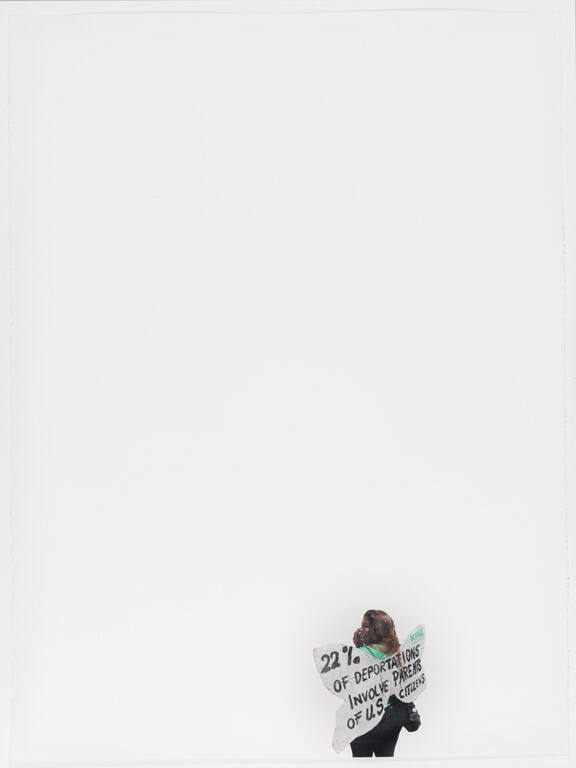
Throughout the Museum
In 2016, the Pew Research Center reported “nearly 1 in 100 people worldwide are now displaced from their homes.”
how the light gets in is an exhibition about the movement of people across the globe and the welcome cracks that develop in our notions of borders and nation states—“that’s how the light gets in,” Leonard Cohen sang in his 1992 song “Anthem”:
Ring the bells that still can ring
Forget your perfect offering
There is a crack in everything
That’s how the light gets in

The exhibition brings together an international group of artists and artist teams and collectives, ranging in age from their twenties to their nineties and representing 29 countries of birth and residence. Their work engages with themes of migration, immigration, displacement, and exile. Artworks including drawing, photography, painting, sculpture, and video will be installed in all of the Museum’s temporary exhibition galleries, contemporary collection gallery, lobbies, and on the facade and grounds.
how the light gets in presents mainly post–9/11 artworks that address conditions of mobility, vulnerability, and the loss of and yearning for home. The featured works reject aestheticizing suffering and aim to restore the dignity of people who migrate, putting parallel spotlights on the ongoing refugee crisis in Europe and the human consequences of US immigration policy, especially along its southern border. Rather than focus on documentary photography, as images of refugees in boats and at border fences continue to inundate the news media, works that prompt identification with migrants and refugees encourage visitors to participate in a narrative of empathy, which, writer Rebecca Solnit has noted, “we tell ourselves to make other people real to us, to feel for and with them, and thereby to extend and enlarge and open ourselves.”
This exhibition and its accompanying programs, while impossible to be comprehensive, are about hope at a time in which migration has become one of the most pressing issues for humanity. Artists can make the heavily mediated mass-migration crisis more tangible, representing often difficult and controversial ideas, and playing a critical role in helping people understand the complicated politics and emotions of the im/migrant experience.
The artists in the exhibition are Saâdane Afif, Sobia Ahmad, Shiva Ahmadi, John Akomfrah, Sama Alshaibi, Mounira Al Solh, Kader Attia, Aziz + Cucher, Radcliffe Bailey, Rina Banerjee, Keren Benbenisty, Dawoud Bey, Jorge Méndez Blake, Phoebe Boswell, Andrea Bowers, Tania Bruguera, Margarita Cabrera, Yoan Capote, Enrique Chagoya, Gohar Dashti, Lois Dodd, Willie Doherty, Fidencio Fifield-Perez, Forensic Oceanography, Meschac Gaba, Cyprien Gaillard, Guillermo Galindo, John Gerrard, Mohamad Hafez, Manaf Halbouni, Mona Hatoum, Alfredo Jaar, Hayv Kahraman, Zoe Leonard, Glenn Ligon, Hew Locke, Teresa Margolles, Elisabeth Masé, Esperanza Mayobre, Richard Misrach, Fiamma Montezemolo, Richard Mosse, Yoshua Okón, Catherine Opie, Lucy + Jorge Orta, Driss Ouadahi, Peng! Collective, Dawit L. Petros, Postcommodity, Ronald Rael and Virginia San Fratello, Jolene K. Rickard with Steve Henhawk and Waylon Wilson, Yinka Shonibare, Aram Han Sifuentes, Shahzia Sikander, Tavares Strachan, Stephanie Syjuco, and Ai Weiwei.
SCREENING SERIES
Held in conjunction with the exhibition, a film and documentary series at Cornell Cinema expanded the scope of the exhibition with additional stories and perspectives.
CITATIONS NEEDED
The podcast recorded a live episode at the Johnson with special guest Shannon Gleeson, associate professor of labor relations, law, and history at Cornell’s ILR School.
REVIEW
Adriana Miramontes Olivas reviewed how the light gets in for Contemporaneity: Historical Presence in Visual Culture, no. 9: Moving Across, Through Cultures (Spring 2021): 82-94. DOI: https://doi.org/10.5195/contemp/2021.327
Read or download a PDF of the review.
This exhibition was curated by Andrea Inselmann, curator of modern and contemporary art at the Johnson, and funded in part by grants from the National Endowment for the Arts, the New York State Council on the Arts, Engaged Cornell, and the Cornell Council for the Arts. It has been supported by generous gifts from Younghee Kim-Wait, Ronni Lacroute ’66, and Jodi Dady and Andrew Dady ’86. Additional support was provided by the Ames Exhibition Endowment.
Selected Artworks

Projection
Mona Hatoum

Die Quelle/The Source
Elisabeth Masé

Participant dress from Ithaca iteration of the artist’s ongoing project, Das Kleid/The Dress
Elisabeth Masé

Das Kleid/The Dress
Elisabeth Masé

OrtaWater—Antarctica
Lucy + Jorge Orta, Lucy Orta, Jorge Orta

Ma Ijtama’t Aydina ala Qabdih illa wa-Kanat Mu-attalah (What Our Hands Joined Was Broken)
Sama Alshaibi

Untitled #1 (Picket fence and farmhouse), from the portfolio Night Coming Tenderly, Black
Dawoud Bey

Boob Gold
Hayv Kahraman












